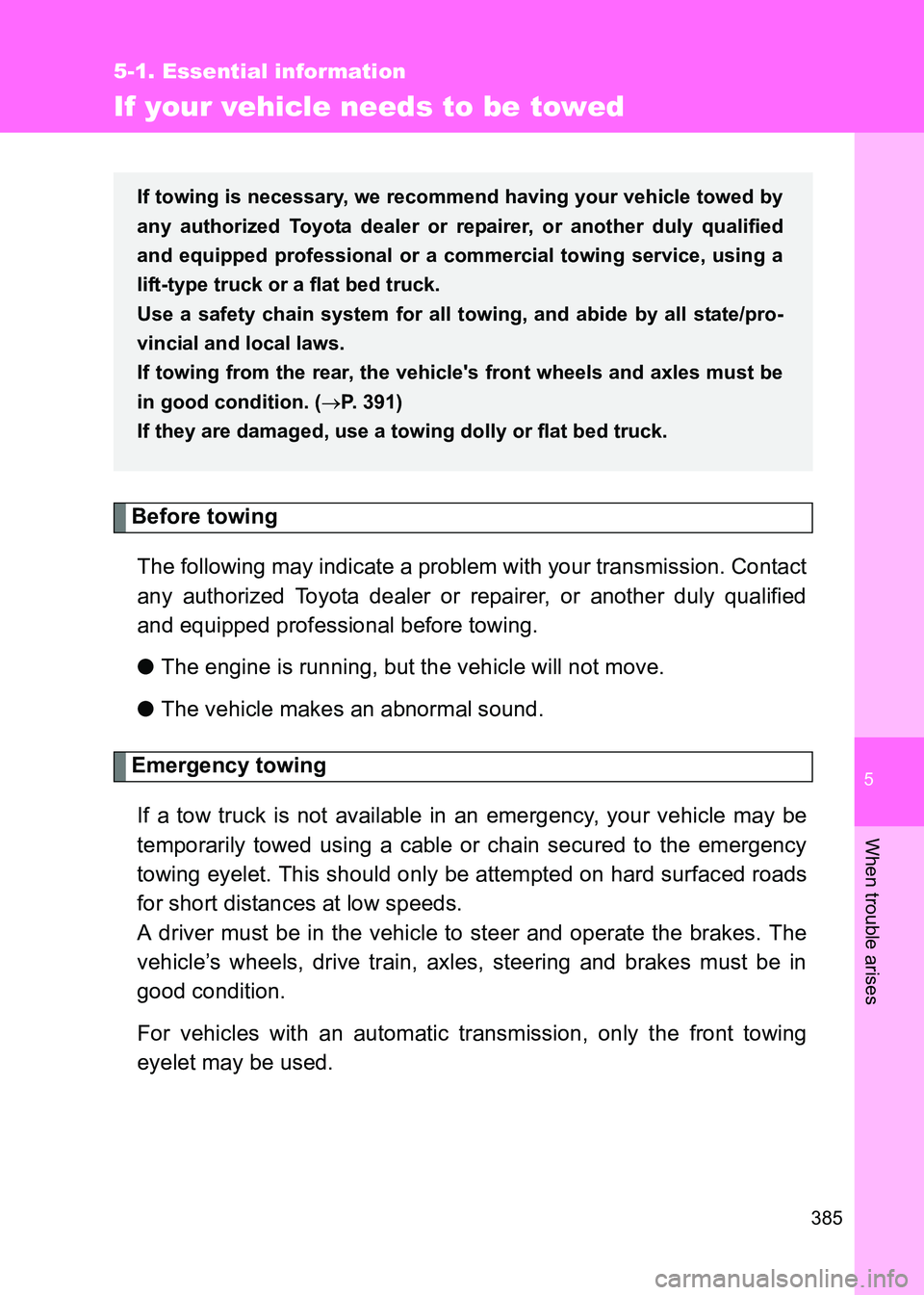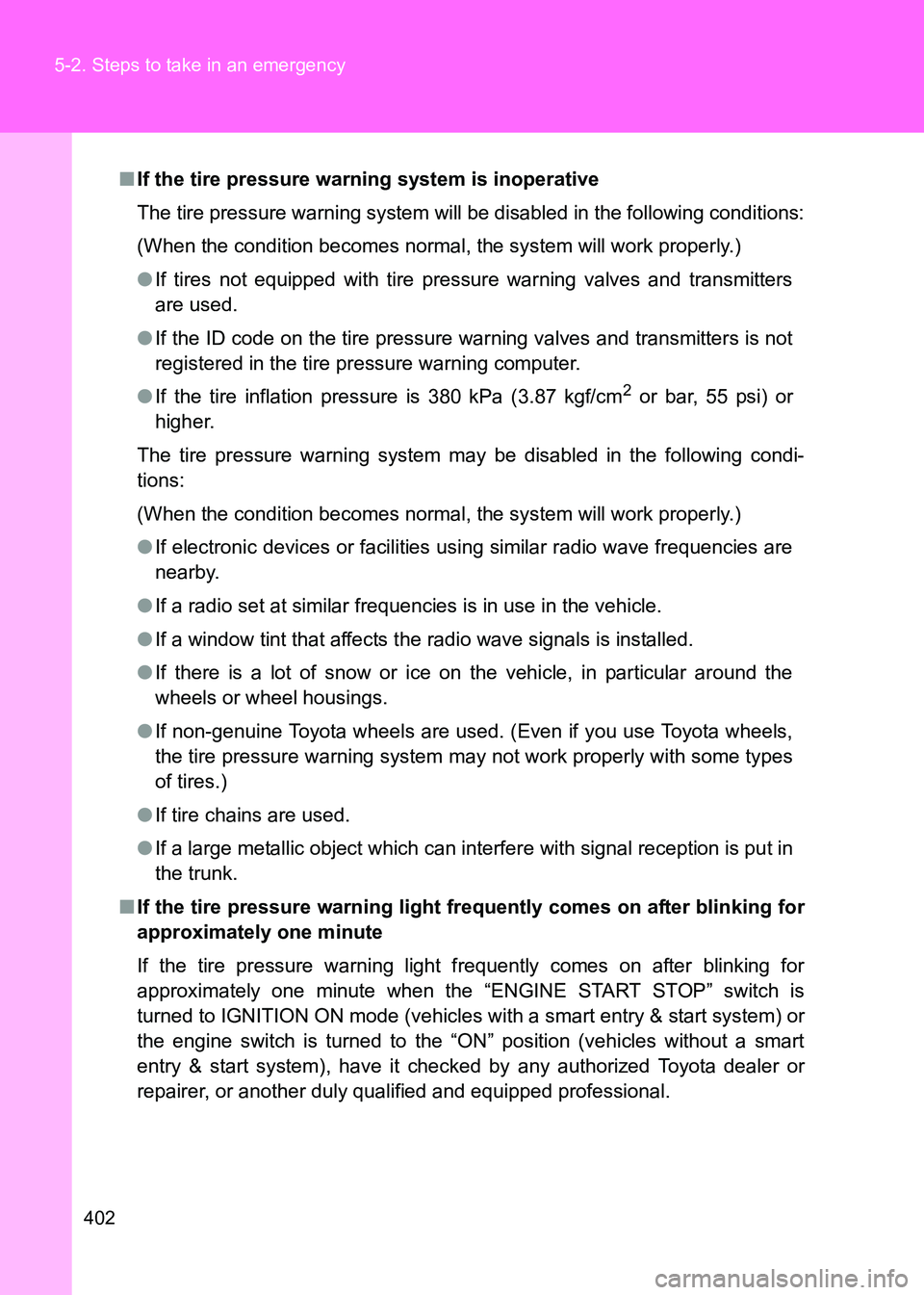2017 TOYOTA GT86 air condition
[x] Cancel search: air conditionPage 385 of 505

5
385
5-1. Essential information
When trouble arises
86_EE (OM18071E)
If your vehicle needs to be towed
Before towingThe following may indicate a problem with your transmission. Contact
any authorized Toyota dealer or repairer, or another duly qualified
and equipped professional before towing.
● The engine is running, but the vehicle will not move.
● The vehicle makes an abnormal sound.
Emergency towing
If a tow truck is not available in an emergency, your vehicle may be
temporarily towed using a cable or chain secured to the emergency
towing eyelet. This should only be attempted on hard surfaced roads
for short distances at low speeds.
A driver must be in the vehicle to steer and operate the brakes. The
vehicle’s wheels, drive train, axles, steering and brakes must be in
good condition.
For vehicles with an automatic transmission, only the front towing
eyelet may be used.
If towing is necessary, we recommend having your vehicle towed by
any authorized Toyota dealer or repairer, or another duly qualified
and equipped professional or a comm ercial towing service, using a
lift-type truck or a flat bed truck.
Use a safety chain system for all to wing, and abide by all state/pro-
vincial and local laws.
If towing from the rear, the vehicle's front wheels and axles must be
in good condition. ( →P. 391)
If they are damaged, use a towing dolly or flat bed truck.
Page 393 of 505

5
393
5-1. Essential information
When trouble arises
86_EE (OM18071E)
If you think something is wrong
If you notice any of the following symptoms, your vehicle probably
needs adjustment or repair. Contact any authorized Toyota dealer or
repairer, or another duly qualified and equipped professional as
soon as possible.
■ Visible symptoms
●Fluid leaks under the vehicle
(Water dripping from the air conditioning after use is normal.)
● Flat-looking tires or uneven tire wear
● Vehicles with a monochrome multi-information display: The
engine coolant temperature gauge needle continually points
higher than normal
● Vehicles with a color multi-information display: The high
engine coolant temperature warning light flashes or illumi-
nates
■ Audible symptoms
●Changes in exhaust sound
● Excessive tire squeal when cornering
● Strange noises related to the suspension system
● Pinging or other noises related to the engine
■ Operational symptoms
●Engine missing, stumbling or running rough
● Appreciable loss of power
● Vehicle pulls heavily to one side when braking
● Vehicle pulls heavily to one side when driving on a level road
● Loss of brake effectiveness, spongy feeling, pedal almost
touches the floor
Page 402 of 505

402
5-2. Steps to take in an emergency
86_EE (OM18071E)
■
If the tire pressure warning system is inoperative
The tire pressure warning system will be disabled in the following conditions:
(When the condition becomes normal, the system will work properly.)
● If tires not equipped with tire pressure warning valves and transmitters
are used.
● If the ID code on the tire pressure warning valves and transmitters is not
registered in the tire pressure warning computer.
● If the tire inflation pressure is 380 kPa (3.87 kgf/cm
2 or bar, 55 psi) or
higher.
The tire pressure warning system may be disabled in the following condi-
tions:
(When the condition becomes normal, the system will work properly.)
● If electronic devices or facilities using similar radio wave frequencies are
nearby.
● If a radio set at similar frequencies is in use in the vehicle.
● If a window tint that affects t he radio wave signals is installed.
● If there is a lot of snow or ice on the vehicle, in particular around the
wheels or wheel housings.
● If non-genuine Toyota wheels are used. (Even if you use Toyota wheels,
the tire pressure warning system may not work properly with some types
of tires.)
● If tire chains are used.
● If a large metallic object which can interfere with signal reception is put in
the trunk.
■ If the tire pressure warning light frequently comes on after blinking for
approximately one minute
If the tire pressure warning light frequently comes on after blinking for
approximately one minute when the “ENGINE START STOP” switch is
turned to IGNITION ON mode (vehicles with a smart entry & start system) or
the engine switch is turned to the “ON” position (vehicles without a smart
entry & start system), have it checked by any authorized Toyota dealer or
repairer, or another duly qualified and equipped professional.
Page 435 of 505

5
435
5-2. Steps to take in an emergency
When trouble arises
86_EE (OM18071E)
WARNING
■
When fixing the flat tire
●After inflation of the tire has completed, the sealant may splatter when the
hose is disconnected or some air is let out of the tire.
● Follow the operation procedure to repair the tire. If the procedures not fol-
lowed, the sealant may spray out.
● Keep back from the tire while it is being repaired, as there is a chance of it
bursting while the repair operation is being performed. If you notice any
cracks or deformation of the tire, turn off the compressor switch and stop
the repair operation immediately.
● The repair kit may overheat if operated for a long period of time. Do not
operate the repair kit continuously for more than 10 minutes.
● Parts of the repair kit become hot during operation. Be careful when han-
dling the repair kit during and after operation. Do not touch the metal part
around the connecting area between the bottle and compressor. It will be
extremely hot.
● Do not attach the vehicle speed warning sticker to an area other than the
one indicated. If the sticker is attached to an area where an SRS airbag is
located, such as the pad of the steering wheel, it may prevent the SRS air-
bag from operating properly.
■ Driving to spread the liquid sealant evenly
Observe the following precautions to reduce the risk of accidents.
Failing to do so may result in a loss of vehicle control and cause death or
serious injury.
●Drive the vehicle carefully at a low speed. Be especially careful when turn-
ing and cornering.
● If the vehicle does not drive straight or you feel a pull through the steering
wheel, stop the vehicle and check the following.
• Tire condition. The tire may have separated from the wheel.
• Tire inflation pressure. If the tire inflation pressure is 130 kPa (1.3
kgf/cm
2 or bar, 19 psi) or less, the tire may be severely damaged.
Page 464 of 505

464
5-2. Steps to take in an emergency
86_EE (OM18071E)
If your vehicle overheats
Correction proceduresStop the vehicle in a safe place and turn off the air condition-
ing system, and then stop the engine.
If you see steam: Carefully lift the hood after the steam subsides.
If you do not see steam: Carefully lift the hood.
After the engine has cooled
down sufficiently, inspect the
hoses and radiator core (radia-
tor) for any leaks.
Radiator
Cooling fans
If a large amount of coolant leaks,
immediately contact any autho-
rized Toyota dealer or repairer, or
another duly qualified and
equipped professional.
The following may indicate that your vehicle is overheating.
●Vehicles with a monochrome multi-information display: The
engine coolant temperature gauge ( →P. 200) enters the red
zone or a loss of engine power is experienced (for example, the
vehicle speed does not increase).
Vehicles with a color multi-information display: The high engine
coolant temperature warning light ( →P. 204) flashes or illumi-
nates or a loss of engine power is experienced (for example, the
vehicle speed does not increase).
● Steam comes out from under the hood.
STEP 1
STEP 2
STEP 3
Page 465 of 505

5
465
5-2. Steps to take in an emergency
When trouble arises
86_EE (OM18071E)
The coolant level is satisfactory if
it is between the “FULL” and
“LOW” lines on the reservoir.
Reservoir
“FULL”
“LOW”
Radiator cap
Add coolant if necessary.
Water can be used in an emer-
gency if coolant is unavailable.
Start the engine and turn the air conditioning system on to
check that the radiator cooling fans operate and to check for
coolant leaks from the radiator or hoses.
The fans operate when the air conditioning system is turned on
immediately after a cold start. Confirm that the fans are operating by
checking the fan sound and air flow. If it is difficult to check these,
turn the air conditioning system on and off repeatedly.
(The fans may not operate in freezing temperatures.)
If the fans are not operating: Stop the engine immediately and contact any authorized
Toyota dealer or repairer, or another duly qualified and
equipped professional.
If the fans are operating: Have the vehicle inspected at the nearest authorized
Toyota dealer or repairer, or another duly qualified and
equipped professional.
STEP 4
STEP 5
STEP 6
STEP 7
Page 488 of 505

488
6-2. Customization
86_EE (OM18071E)
Wireless
remote con-
trol
(
→P. 52)
Trunk unlocking opera-
tion
Push and hold
(short) Push and hold
(long)
One short push Two short pushes
Emergency
brake signal
(
→P. 246) Operation signal
(Emergency flashers)
On Off
Automatic
light control
system
( → P. 231) Light sensor sensitivity ±0% -40% to +40%
Lights
(
→P. 231) Time that the low beam
headlights are on when
the vehicle is parked
30 seconds60 seconds
90 seconds
120 seconds
Rear window
defogger
(
→P. 282) Time elapsed before
the rear window defog-
ger turn off (vehicles
with an automatic air
conditioning system)
15 minutes Continue
Illumination
(
→P. 286) Time elapsed before
lights turn off
15 seconds7.5 seconds
30 seconds
Operation when the
doors are unlocked On Off
Operation after the
engine switch is turned
off On Off
Interior light illumination
upon approach (vehi-
cles with a smart entry
& start system) On Off
Interior light illumination On Off
ItemFunctionDefault settingCustomized setting
Page 491 of 505

491
86_EE (OM18071E)
Alphabetical index
Alphabetical index
A/C..................................... 266, 274
ABS ........................................... 246
Air conditioning filter .............. 357
Air conditioning systemAir conditioning filter.............. 357
Automatic air conditioning
system ................................ 274
Manual air conditioning system ................................ 266
Airbags Airbag manual on/off
system ................................ 155
Airbag operating conditions ................... 115, 121
Airbag precautions for your child ............................ 127
Airbag warning light .............. 397
Curtain shield airbag
operating conditions ........... 121
Curtain shield airbag precautions ......................... 127
General airbag precautions... 127
Locations of airbags.............. 106
Modification and disposal of airbags.............. 132
Proper driving posture... 104, 127
Side airbag operating conditions ........................... 121
Side airbag precautions ........ 127
Side and curtain shield
airbags operating
conditions ........................... 121
Side and curtain shield airbags precautions ............ 127
SRS airbags .......................... 106 Anti-lock brake system ........... 246
Ashtray ..................................... 296
Audio input............................... 284
Audio system
Audio input ............................ 284
AUX port ............................... 284
Portable music player ........... 284
Steering wheel audio
switches.............................. 285
USB port ............................... 284
Automatic air conditioning
system .................................... 274
Automatic headlight leveling system ..................... 234
Automatic light control system....................... 231
Automatic transmission
Automatic transmission......... 186
If the shift lever cannot be shifted from P ..................... 453
Manual mode ........................ 189
Mode select switch ............... 188
Paddle shift levers ................ 189
AUX port ................................... 284
Auxiliary box ............................ 304A